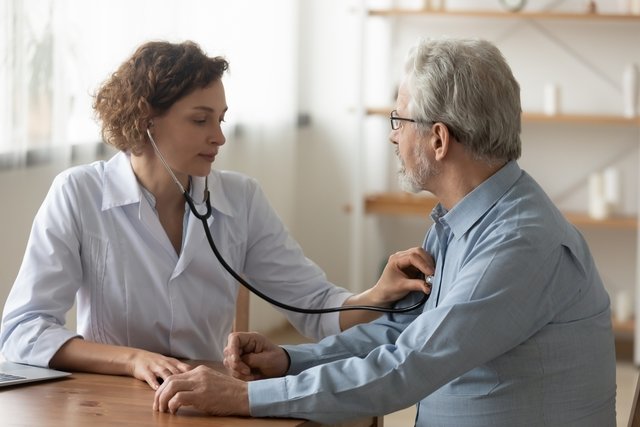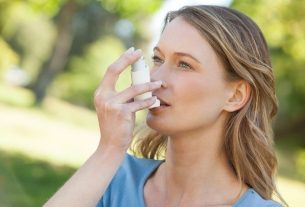Dyspnea is the sensation of shortness of breath, which usually appears when practicing some physical activity, but which can also occur in situations of anxiety, for example. Generally, dyspnea is also accompanied by other symptoms such as tiredness, chest tightness or irregular and accelerated breathing.
Dyspnea can also be caused by heart diseases or diseases that directly affect the lungs, such as asthma, pneumonia and chronic obstructive pulmonary disease (COPD). Learn about other symptoms of COPD.
The treatment of dyspnea should always be guided by a general practitioner, pulmonologist or cardiologist, according to the cause of shortness of breath and the types of dyspnea, which may include physical exercise, use of medication, oxygen therapy and respiratory physiotherapy, for example. example.

Dyspnea symptoms
The main symptoms of dyspnea are:
- Difficulty breathing;
- Tiredness;
- Irregular and accelerated breathing;
- Cough.
In most cases, dyspnea is temporary and improves within a few minutes, however, if dyspnea persists for a long time, worsens or is accompanied by other symptoms such as severe tightness in the chest, bluish fingers or lips, pain that radiates to back, neck or jaw, it is essential to seek emergency medical care.
How to confirm the diagnosis
The diagnosis of dyspnea must be made by a general practitioner, pulmonologist or cardiologist, through evaluation of the signs and symptoms presented by the person, health history and physical examinations.
Make an appointment with the nearest pulmonologist to assess the possibility of dyspnea:
Taking care of your health has never been easier!
The doctor may also order some more specific tests and exams to check whether or not the dyspnea is caused by a heart or lung disease, such as pulse oximetry, chest x-ray, lung function test, exercise tests and computed tomography. In some cases, it may also be necessary to take a blood test to check for anemia.
Main causes
Dyspnea can be caused by different situations, such as heart and lung diseases, and can be acute, when it appears suddenly and lasts only a few days, or chronic, when it can happen for 1 month or longer.
1. Acute dyspnea
The main causes of acute dyspnea, which appears suddenly and may disappear after a few days, are:
- Anaphylaxis, a type of severe allergic reaction;
- Stress or anxiety;
- Choking;
- Pulmonary embolism;
- Heart attack;
- Lung infection, such as pneumonia or bronchitis;
- Rib injury;
- Medicines, such as statins and beta blockers;
- Very extreme ambient temperature.
Furthermore, COVID-19 is an infection that can also cause difficulty breathing or shortness of breath. Understand how shortness of breath can occur in COVID-19.
2. Chronic dyspnea
Chronic dyspnea usually lasts for at least 1 month and can be caused by situations such as:
- Asma;
- Bronchitis;
- Cardiac insufficiency;
- Lung problems, such as COPD, tuberculosis and lung tumors;
- Obesity;
- Lack of physical conditioning.
Other health problems that can also cause chronic dyspnea include anemia, Guillain-Barré syndrome, and myasthenia gravisa condition that causes muscle weakness, which can compromise lung functions.
Types of dyspnea
Dyspnea can be classified according to the presence of heart or lung diseases, and the main types are:
Dyspnea on exertion
Exertional dyspnea happens when a person has difficulty breathing while doing activities that they previously did without much effort. This type of dyspnea is more common in people who have a problem with their heart or lungs.
Decubitus dyspnea
This type of dyspnea, also called orthopnea, occurs when a person has difficulty breathing immediately after lying down. This type of dyspnea may also be related to a heart or lung disease.
Paroxysmal dyspnea
Paroxysmal dyspnea, also known as paroxysmal nocturnal dyspnea, is difficulty breathing that occurs during sleep, where the person generally wakes up in the early hours of the morning with shortness of breath, and may also experience coughing and wheezing, which generally improve when the person becomes sit or stand. Learn about other symptoms of paroxysmal dyspnea.
How the treatment is carried out
The treatment of dyspnea must be guided by a doctor according to the causes of difficulty breathing and the most recommended treatments for this condition include:
1. Physical exercises
Physical exercises must be carried out under the supervision of a specialized professional and can be recommended to help people who have dyspnea caused by excess body weight lose weight. Furthermore, physical exercise also helps to strengthen the lung and heart muscles, helping to combat dyspnea.
2. Respiratory physiotherapy
Respiratory physiotherapy helps to improve the supply of oxygen to the body, being indicated to improve breathing and the quality of life of people with dyspnea caused by asthma, bronchitis and tuberculosis, for example. Understand what respiratory physiotherapy is for.
3. Oxygen therapy
Oxygen therapy is a therapy carried out through a mask, or catheter, to improve the oxygenation of the lungs and body cells, improving the breathing of people with COPD, asthma and pneumonia, for example. See the different types of oxygen therapy.
4. Medicines
Some medications, such as bronchodilators and corticosteroids, may be indicated to relax the lung muscles and relieve shortness of breath in cases of dyspnea caused by asthma or COPD, for example. Calming medications and analgesics can be indicated to alleviate dyspnea in people with stress and anxiety.
Antibiotics, antihistamines and decongestants may be indicated for the treatment of sinusitis, flu and respiratory infections, relieving dyspnea in these cases. In cases of difficulty breathing caused by heart failure, diuretic medications may be recommended.

Sign up for our newsletter and stay up to date with exclusive news
that can transform your routine!
Warning: Undefined array key "title" in /home/storelat/public_html/wp-content/plugins/link-whisper-premium/templates/frontend/related-posts.php on line 12
Warning: Undefined array key "title_tag" in /home/storelat/public_html/wp-content/plugins/link-whisper-premium/templates/frontend/related-posts.php on line 13



